The chords here are designed to be used in place of a standard chord anywhere you feel the need for more pizzazz. So, for example, you could replace a G7 chord in a song with the G9 chord in this article and give the song a new feel. This is known as chord substitution.
A change of just one or two notes can make a chord tense, mellow, bright, or moody. Test this out in songs and let your ears tell you whether it’s the right place for one of these chords.
So warm up your fingers, prick up your ears, and get ready to try some of the greatest chords on your ukulele.
Invigorating C (with a High Note)
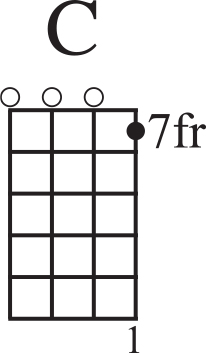
The average uker spends 17 days of his or her life playing a C chord. So, you may feel the need to reinvigorate it sometimes. You can do this easily by fretting the A-string at the 7th fret rather than the 3rd fret, as shown. The high note at the top gives the chord a sprightly ring to it.
The number at the top right in the figure indicates the fret the chord diagram starts on. And the number or numbers at the bottom indicate the finger you use to fret the string. In this case, 7fr means the diagram starts at the 7th fret and you use your index finger to fret it.
Use it: Whenever you use a C chord.
In a progression: C – Am7 – F – G7 – C
Shimmering A Minor 7 (High Up)
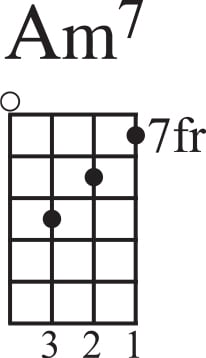
The version of Am7 in Figure 24-2 includes notes high up the fretboard which give the chord a shimmering, mandolin-like tone. The chord fits nicely with the “C with a high note” variation.
The chord is easy to play. You just take the Em chord shape and move it up the fretboard so your index finger is on the 7th fret.
Use it: Whenever you have a standard Am7. You can also use it in place of an Am most of the time.
In a progression: C – Am7 – F – G7 – C
Melancholy F Major 7
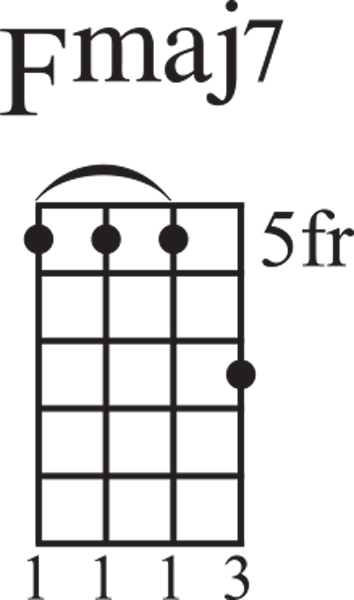
Major chords are straightforward, pleasant chords. So, it’s nice to mix in a melancholy and expectant major 7 note now and then.
You can play Fmaj7 in lots of different ways. The version in the figure uses a barre at the 5th fret. This isn’t the easiest way to play the chord, but it slips nicely into this progression with the new C and Am7 chords.
Use it: When you have an F chord and want to make it more reflective.
In a progression: C – Am7 – Fmaj7 – G7 – C
Complex G9
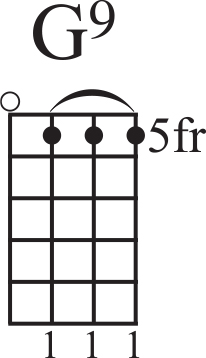
G9 is a complex, jazzy chord: so complex it has too many notes to be played on the ukulele. The full chord is packed with five notes so it’s necessary to drop one of the less important notes.
The version in this figure of the chord drops the major third. That makes this version ambiguous-sounding.
Use it: When you want to make a G7 chord complex and cryptic.
In a progression: C – Am7 – Fmaj7 – G9 – C
Chilled Out G6
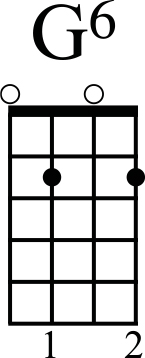
G6 is a chord so fly that Far East Movement wrote a song about it. It’s often used in Hawaiian music and has that island sound. It’s a laid-back, no-stress chord. G6 is also easy to play. Just play the standard G chord and take off your ring finger, as shown.
Use it: When you want to make a G or G7 chord mellow.
In a progression: G6 – D7 – G6
The “Hawaiian” D7
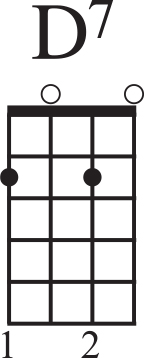
The version of the D7 in the following figure is often referred to as the Hawaiian D7. There’s nothing specifically Hawaiian about it, but it has a more relaxed sound that fits very nicely with the G6 chord. Changing between the two is easy because it’s the same shape moved along one string.
Use it: In place of a standard D7.
In a progression: G6 – D7 – G6
Uncomfortable A Augmented 7
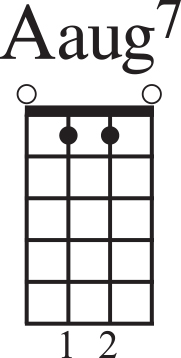
Aaug7 is a very dissonant chord, uncomfortable to listen to. That makes the listener eager for the chord to resolve into a more relaxed chord, giving the progression great momentum.
That momentum is a huge power for a chord to possess. Be careful with it. Use Aaug7 in the wrong place and you’ll throw the whole progression off.
Use it: Where you have an A7 chord and you want to create a huge amount of tension. Aaug7 is perfect at the end of an intro because it propels the song into the first verse.
In a progression: D – G – D – Aaug7 – D
Jazzy C9
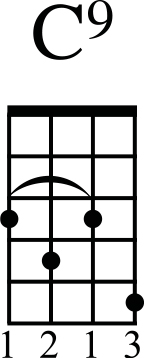
Because you have to drop one of the notes from a 9 chord to fit it on a ukulele, you have an opportunity to create subtly different versions. The inversion in the following figure drops the root note (C in this case). It retains the third so it has a more major sound than the G9.
You’re fretting every string so you can move this chord shape up and down the neck. For example, move the whole shape up two frets and you have a D9 chord.
Use it: Whenever you have a C7 chord and want to be super jazzy.
In a progression: F – C9 – F – C9
Menacing F Minor 9
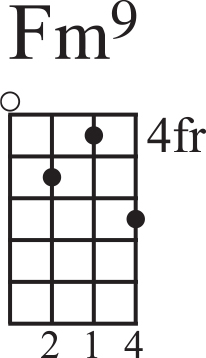
Just as you can substitute C7 and G7 chords with C9 and G9, minor chords can become minor 9 chords. The Fm9 chord has the same complexity, but the minor note gives it an unsettling feeling.
Use it: When you have an Fm7 chord or an Fm chord and want to add a hint of menace.
In a progression: C – G – F – Fm9 – C
Nostalgic E Diminished 7
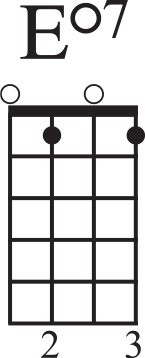
The diminished chord is the most mysterious chord there is and a favorite amongst jazzers. It has a nostalgic feel thanks to its near ubiquity in the ukulele’s ’20s and ’30s heyday. The following figure shows the Edim7 chord.
Use it: In place of a C7 chord.
In a progression: C – Edim7 – G7 – A7 – D7 – G7 – C

